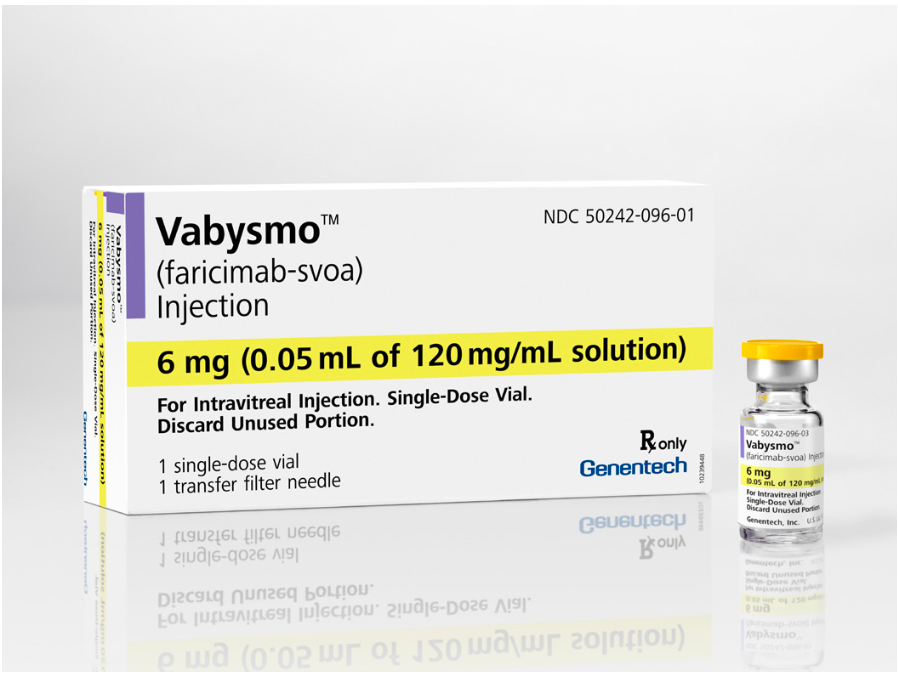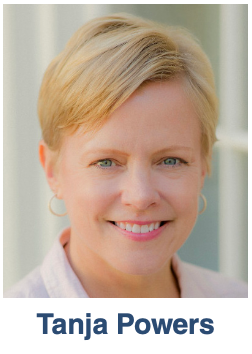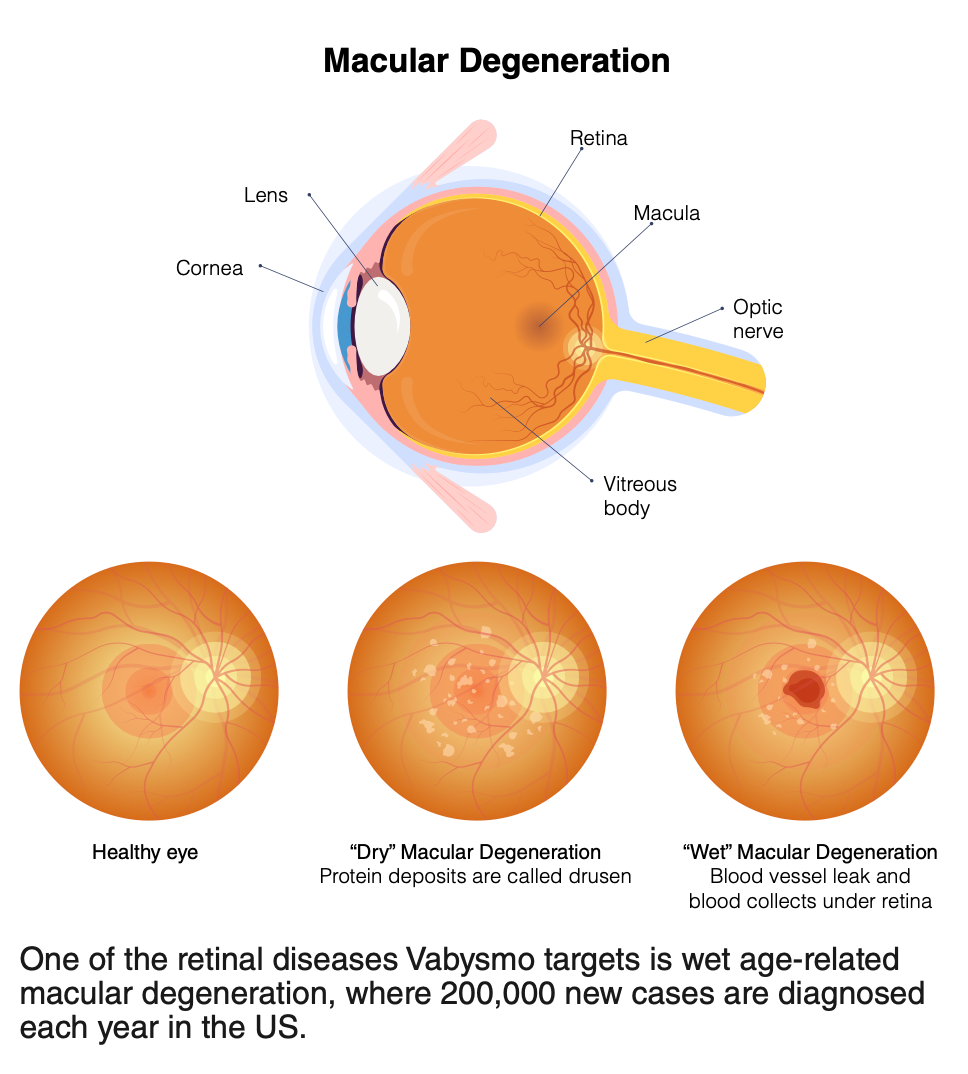Fighting Vision Loss: Vabysmo
Use against pair of pathways could pave way for standout in stocked eye disease market.

With Roche/Genentech’s sights set on helping patients suffering from blinding eye conditions, it turned to an innovative bispecific antibody therapy. Vabysmo (faricimab-svoa), the first bispecific antibody approved for the eye, was approved Jan. 28, and analysts expect it will become a blockbuster drug by 2026.
Vabysmo treats two retinal diseases that are leading causes of vision loss—diabetic macular edema (DME) and wet age-related macular degeneration (wet AMD). Nearly 40 million people globally suffer from these conditions. The therapy works by targeting two disease pathways, angiopoietin-2 (Ang-2) and vascular endothelial growth factor-A (VEGF-A), which are both thought to contribute to vision loss by destabilizing blood vessels and causing new leaky blood vessels to form and increase inflammation.
Vabysmo offers a new way to treat vision loss through its dual mechanism of action. The treatment is the only injectable eye medicine to be approved simultaneously in the US for both wet AMD and DME.Vabysmo has demonstrated comparable efficacy and safety in clinical trials as Regeneron/Bayer’s Eylea, currently the standard of care for wet AMD and DME. As a new competitor for Eylea (aflibercept), which also treats both eye conditions, Vabysmo stands out for requiring fewer treatments—after initial dosing, up to four months in between injections, compared to Eylea’s one to two months.

“Because it is a first-of-its-kind treatment, Vabysmo is in a league of its own,” says Tanja Powers, vice president of commercial ophthalmology at Genentech. “For many patients and caregivers, this new option could have a big impact on their lives. Our data shows Vabysmo can improve vision as well as a current standard of care, with potentially fewer injections over time.”
Communicating Vabysmo’s benefits
In developing its core messaging, Roche/Genentech decided to focus on why Vabysmo stands out and why it is an exciting option for customers and patients. The launch team wanted to emphasize innovation and durability.
“With our ‘Where 2 Worlds Meet’ campaign aimed at retina specialists, we focused on Vabysmo being the first and only treatment in wet AMD and DME to target two pathways, while others only target one,” says Powers. “Safety is also paramount, and when speaking to our customers, we pair the efficacy data with safety data clearly demonstrating Vabysmo’s safety profile is similar to the comparator across four large clinical studies.”
While the team recognized the importance of reaching patients with its messaging, much of its energy during the initial launch was focused on healthcare professionals. The company also has leveraged other promotional channels, as well as partners to reach its customers.
“We want to make sure that everyone who is part of the patient journey is aware of Vabysmo, excited by what it has to offer, and ultimately chooses Vabysmo,” says Powers. “We understand there are other treatment options available, including our own Lucentis [ranibizumab], so we have a sizable field team to ensure that we deliver for patients and caregivers.”
Ensuring healthcare providers and patients have easy access to Vabysmo also was a critical initiative; the drug is now covered by most payers.
Competition and the future
Although Vabysmo is a novel drug, it still shares the market with other therapies and will need to keep an eye on them. Currently, with $9.2 billion in sales in 2021, Eylea is its most direct competitor. While Vabysmo seems to have the edge for duration over Eylea, as mentioned earlier, Regeneron/Bayer is working on a higher-dose version of its drug, which could be administered every four months.

Roche/Genentech also has to contend in-house with its blockbuster Lucentis, which brought in $1.46 billion in 2021.
Another player in the space is Beovu (brolucizumab-dbll). Made by Novartis—which markets Lucentis outside the US—Beovu, was approved in 2019 but has faced some safety concerns. It had $186 million in sales in 2021, down from $190 million in 2020.Gene therapies and biosimilars in development also pose future competition.
Q2 sales for Vabysmo were about $112 million globally, and Evaluate projects sales of $1.1 billion by 2026. This will come not just from gaining market share within its current indications but from widening its therapeutic net.
“We have a lot of exciting milestones to come for Vabysmo in new indications,” says Powers. “We’re looking forward to sharing results from our Phase III trials for Vabysmo to treat macular edema following retinal vein occlusion, or RVO.”
As Roche/Genentech’s innovation in ophthalmology continues to explore areas such as gene therapy, and the application of artificial intelligence and machine learning to advance the field, it also is committed to building diversity and inclusion into research.
“We are currently conducting the Phase IV Elevatum study of Vabysmo in underrepresented patient populations with DME,” says Powers. “What we learn in this trial, we hope to apply more broadly to our clinical program and scientific understanding, to help ensure more equitable care for all.”
Read the profiles of all 2022 product launch selections here.

FDA Grants Priority Review to Regeneron’s Eylea for Macular Edema Following Retinal Vein Occlusion
April 18th 2025Regulatory action was based on data from the Phase III QUASAR trial, which demonstrated that Eylea HD dosed every eight weeks achieved non-inferior visual acuity outcomes compared to Eylea in patients with macular edema following retinal vein occlusion.
Addressing Disparities in Psoriasis Trials: Takeda's Strategies for Inclusivity in Clinical Research
April 14th 2025LaShell Robinson, Head of Global Feasibility and Trial Equity at Takeda, speaks about the company's strategies to engage patients in underrepresented populations in its phase III psoriasis trials.
The Misinformation Maze: Navigating Public Health in the Digital Age
March 11th 2025Jennifer Butler, chief commercial officer of Pleio, discusses misinformation's threat to public health, where patients are turning for trustworthy health information, the industry's pivot to peer-to-patient strategies to educate patients, and more.